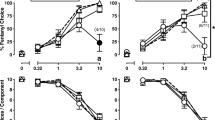Abstract
Different groups of rats were trained to discriminate fentanyl (F) (0.03, 0.02, or 0.01 mg/kg) from saline or to discriminate 0.03 mg/kg fentanyl (F) from alternative stimulus conditions (saline, 0.15 mg/kg nicotine, or 0.01 mg/kg F). When percentage of responses on the drug lever and percentage of time spent responding on the drug lever were used as dependent variables, it was found that training dose and alternative stimulus condition both affected the ED50 and the slope of the F generalization gradient. ED50 and slope values based on group data were not significantly different from values based on individual data. Differences between the results of the first and second 2.5-min period of the extinction test were not significant. ED50 and slope values were unaffected by the preceding training session, except in the group trained to discriminate 0.03 from 0.01 mg/kg F. A lever selection measure showed a significant effect of alternative stimulus condition on ED50 values only.
Training dose and alternative stimulus condition also affected the generalization to morphine. Under none of the conditions explored in this study did generalization occur to amphetamine or nicotine. The results are discussed in terms of the relative nature of drug generalization.
Similar content being viewed by others
References
Barry H III (1974) Classification of drugs according to their discriminable effects in rats. Fed Proc 33:1814–1824
Chance WT, Murfin D, Krynock GM, Rosecrans JA (1977) A description of the nicotine stimulus and tests of its generalization to amphetamine. Psychopharmacology 55:19–26
Colpaert FC, Niemegeers CJE, Janssen PAJ (1976) Theoretical and methodological considerations in drug discrimination learning. Psychopharmacologia 46:169–177
Colpaert FC, Rosecrans JA (1978) Stimulus properties of drugs: Ten years of progress. Elsevier-North Holland Biomedical Press, Amsterdam
Colpaert FC, Niemegeers CJE, Janssen PAJ (1980a) Factors regulating drug cue sensitivity: The effect of training dose in fentanyl-saline discrimination. Neuropharmacology 19:705–713
Colpaert FC, Niemegeers CJE, Janssen PAJ (1980b) Factors regulating drug cue sensitivity: Limits of discriminability and the role of a progressively decreasing training dose in fentanyl-saline discrimination. J Pharmacol Exp Ther 212:474–480
Extance K, Goudie AJ (1981) Interanimal olfactory cues in operant drug discrimination procedures in rats. Psychopharmacology 73:363–371
Greenberg J, Kuhn DM, Appel JB (1975) Behaviorally induced sensitivity to the discriminable properties of LSD. Psychopharmacologia 43:229–232
Järbe TUC, Rollenhagen CV (1978) Morphine as a discriminative cue in gerbils: Drug generalization and antagonism. Psychopharmacology 58:271–275
Kuhn DM, Appel JB, Greenberg J (1974) An analysis of some discriminative properties of d-amphetamine. Psychopharmacologia 39:57–66
Litchfield JT, Wilcoxon F (1949) A simplified method of evaluating dose-response experiments. J Pharmacol Exp Ther 96:99–113
Overton DA (1974) Experimental methods for the study of state-dependent learning. Fed Proc 33:1800–1813
Richards DW III (1978) A functional analysis of the discriminative stimulus properties of amphetamine and pentobarbital. In: Ho BT, Richards DW III, Chute DL (eds) Drug discrimination and state-dependent learning. Academic Press, New York, pp 227–247
Shannon HE, Holtzman SG (1979) Morphine training dose: A determinant of stimulus generalization to narcotic antagonists in the rat. Psychopharmacology 61:239–244
Siegel S (1956) Nonparametric statistics for the behavioral, sciences. McGraw Hill, New York
Snedecor GW, Cochran WG (1967) Statistical methods, 6th edn. Iowa University Press, Iowa
Stolerman IP, D'Mello GD (1981) Role of training conditions in discrimination of central nervous system stimulants by rats. Psychopharmacology 73:295–303
Waters WH, Richards DW III, Harris RT (1972) Discriminative control and generalization of the stimulus properties of d,l-amphetamine in the rat. In: Singh JM, Miller L, Lal H (eds) Drug addiction, vol I. Experimental pharmacology. Futura, New York, pp 87–98
Winer BJ (1971) Statistical principles in experimental design, 2nd edn. McGraw Hill, New York
Winter JC (1978) Drug-induced stimulus control. In: Blackman DE, Sanger DJ (eds) Contemporary research in behavioral pharmacology. Plenum Press, New York, pp 209–237
Author information
Authors and Affiliations
Rights and permissions
About this article
Cite this article
Koek, W., Slangen, J.L. The role of fentanyl training dose and of the alternative stimulus condition in drug generalization. Psychopharmacology 76, 149–156 (1982). https://doi.org/10.1007/BF00435269
Received:
Accepted:
Issue Date:
DOI: https://doi.org/10.1007/BF00435269




